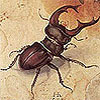|
Walton Ford (born 1960) is an American artist who paints
large scale watercolors in the style of Audubon's naturalist illustrations. Each
painting is a meticulous study in flora and fauna, while being filled with
symbols, clues and jokes referencing a multitude of texts from colonial
literature and folktales to travel guides. Ford's paintings are complex
narratives that critique the history of colonialism, industrialism, politics,
natural science, and man's effect on the environment.
Walton Ford appropriates the crisp, descriptive style of 19th-century
naturalists and artists≈John James Audubon, Karl Bodmer, George Catlin≈but he
puts their conventions to work in an investigation of natural history itself.
Repurposing a field-guide aesthetic, Ford composes dense allegories that make
sometimes pointed, sometimes sidelong allusions to everything from
conservationism and consumption to war, politics and imperialism.
While staying uncannily faithful to the natural history mode, Ford paints on a
much larger scale, producing outsize watercolors with epic compositions. He
renders his scenes with operatic drama, capturing moments when the natural order
changes, such as the last member of a species struggling just before
extinction.■
Walton Ford is the recipient of several national awards and honors including a
fellowship from the John Simon Guggenheim Memorial Foundation and the National
Endowment for the Arts and is one of the artists profiled on the PBS series
Art:21. He had his first major one-man show at the Brooklyn Museum in 2006 and
is currently represented by the Paul Kasmin Gallery in Manhattan.
After living in New York City for more than 10 years, Ford moved his family and
studio to Great Barrington, Massachusetts.
Monographs:
Walton Ford: Pancha Tantra Taschen Books, 2007
Walton Ford: Tigers of Wrath, Horses of Instruction Harry N. Abrams Book, 2002 |
